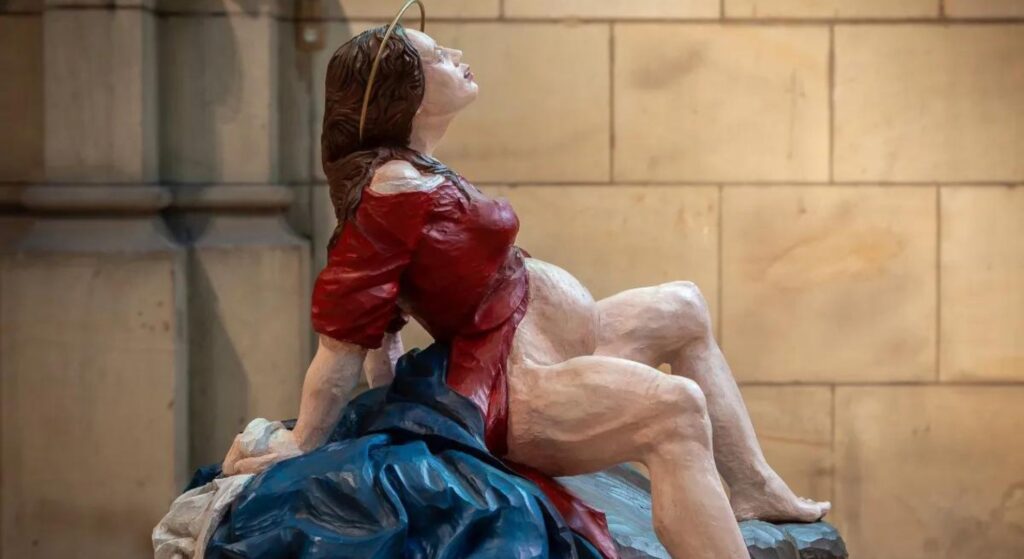A sculpture depicting the Virgin Mary giving birth to Jesus was destroyed mere days after its installation in a northern Austrian cathedral. The artwork, titled “Crowning” by Austrian artist Esther Strauss, has been a focal point of intense debate among Catholics and art enthusiasts alike.
Early Monday morning, vandals sawed off the head of the Virgin Mary in an act of desecration. The Catholic Diocese of Linz has removed the artwork and reported the incident to the authorities. Johann Hintermaier, episcopal vicar for education, art, and culture, expressed deep regret to those offended by the piece but firmly condemned the vandalism as an attack on artistic freedom.
Strauss described the vandal’s actions as “brutal,” and the incident has brought attention to the broader issue of how contemporary art intersects with religious sensibilities. “Crowning” was part of a larger exhibition celebrating the 100th anniversary of St. Mary’s Cathedral’s consecration, focusing on women’s roles and gender equality.
An online petition demanding the sculpture’s removal amassed over 12,000 signatures. Critics argued that the explicit depiction of the Nativity undermined its sacredness. Designed to provide a feminist perspective, Strauss’s work referenced a Nativity scene by Sebastian Osterrieder at the cathedral, challenging traditional depictions of the Virgin Mary often created by men.
The sculpture’s destruction was celebrated by traditionalist Catholic Alexander Tschugguel, who labeled the artwork as “blasphemous.” Tschugguel shared a statement from the purported vandal, who claimed he had unsuccessfully tried to contact the diocese before taking “urgent and decisive action.”
“Crowning” diverges significantly from conventional representations of the Virgin Mary, which typically show her in serene, maternal poses. Instead, Strauss’s work captures Mary in the throes of childbirth, emphasizing her physical and emotional strength. Strauss explained that she intended to reclaim Mary’s body from patriarchal interpretations.
Martina Resch, a theologian at the Catholic Private University of Linz and an organizer of the display, described how visitors were introduced to the sculpture “very gently,” first seeing Mary’s back and then approaching her to form their own perspective. Resch highlighted the piece’s ability to show Mary in both vulnerability and strength.

The destruction of “Crowning” is not an isolated incident. Historical precedents include the controversy over Chris Ofili’s portrait of the Virgin Mary in 1999 and the recent backlash against a “homoerotic” painting of Jesus in Seville.
Adding a contemporary layer to the discussion, Kira, a YouTuber from “TheArtRevival,” posted a video analyzing the incident. The video sparked a wave of reactions, with many viewers interpreting the vandalism as a broader attack on women’s representation and autonomy. Kira’s commentary highlighted how the sculpture’s destruction goes beyond religious offense, touching on deeper issues of gender and artistic expression.
This incident has ignited a multifaceted debate, challenging the boundaries of artistic expression and the role of contemporary art in religious contexts. As discussions continue, “Crowning” serves as a powerful reminder of the ongoing tensions between tradition and modernity in the art world.
Other POP! stories you might like:
Shannen Doherty reportedly leaves a list of people she doesn’t want to attend her funeral
Voice actor Tom Kenny reveals SpongeBob Squarepants is autistic
Shiloh Jolie drops father’s last name due to ‘painful events’
Japan government officially bids farewell to floppy disks, marks an end of an era
GCash reminds users about validity of transactions after altered e-wallet receipts go on sale online

